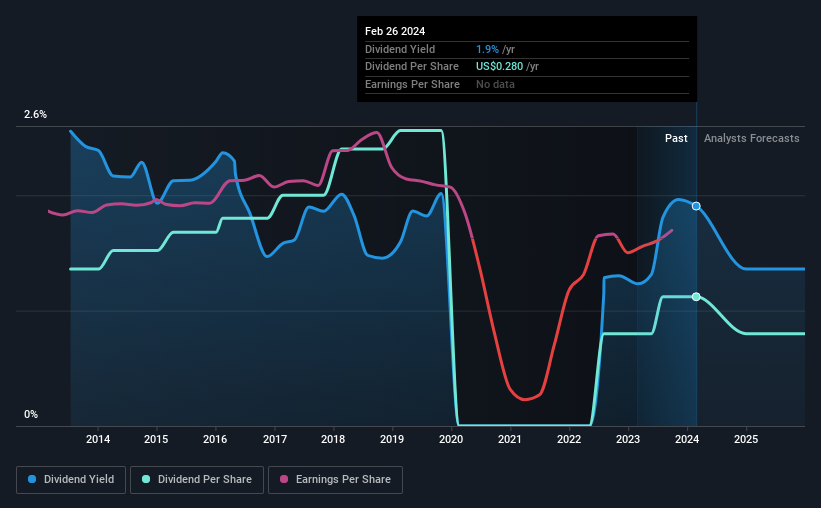Why It Might Not Make Sense To Buy The Marcus Corporation (NYSE:MCS) For Its Upcoming Dividend
The Marcus Corporation (NYSE:MCS) is about to trade ex-dividend in the next three days. The ex-dividend date occurs one day before the record date which is the day on which shareholders need to be on the company's books in order to receive a dividend. It is important to be aware of the ex-dividend date because any trade on the stock needs to have been settled on or before the record date. This means that investors who purchase Marcus' shares on or after the 1st of March will not receive the dividend, which will be paid on the 15th of March.
The company's next dividend payment will be US$0.07 per share. Last year, in total, the company distributed US$0.28 to shareholders. Last year's total dividend payments show that Marcus has a trailing yield of 1.9% on the current share price of US$14.69. We love seeing companies pay a dividend, but it's also important to be sure that laying the golden eggs isn't going to kill our golden goose! That's why we should always check whether the dividend payments appear sustainable, and if the company is growing.
See our latest analysis for Marcus
Dividends are typically paid out of company income, so if a company pays out more than it earned, its dividend is usually at a higher risk of being cut. Last year Marcus paid out 101% of its profits as dividends to shareholders, suggesting the dividend is not well covered by earnings. That said, even highly profitable companies sometimes might not generate enough cash to pay the dividend, which is why we should always check if the dividend is covered by cash flow. It paid out 10% of its free cash flow as dividends last year, which is conservatively low.
It's disappointing to see that the dividend was not covered by profits, but cash is more important from a dividend sustainability perspective, and Marcus fortunately did generate enough cash to fund its dividend. If executives were to continue paying more in dividends than the company reported in profits, we'd view this as a warning sign. Extraordinarily few companies are capable of persistently paying a dividend that is greater than their profits.
Click here to see the company's payout ratio, plus analyst estimates of its future dividends.
Have Earnings And Dividends Been Growing?
Businesses with shrinking earnings are tricky from a dividend perspective. If business enters a downturn and the dividend is cut, the company could see its value fall precipitously. Marcus's earnings have collapsed faster than Wile E Coyote's schemes to trap the Road Runner; down a tremendous 38% a year over the past five years.
Another key way to measure a company's dividend prospects is by measuring its historical rate of dividend growth. Marcus's dividend payments per share have declined at 1.9% per year on average over the past 10 years, which is uninspiring.
To Sum It Up
Is Marcus an attractive dividend stock, or better left on the shelf? It's not a great combination to see a company with earnings in decline and paying out 101% of its profits, which could imply the dividend may be at risk of being cut in the future. Yet cashflow was much stronger, which makes us wonder if there are some large timing issues in Marcus's cash flows, or perhaps the company has written down some assets aggressively, reducing its income. It's not the most attractive proposition from a dividend perspective, and we'd probably give this one a miss for now.
Although, if you're still interested in Marcus and want to know more, you'll find it very useful to know what risks this stock faces. To help with this, we've discovered 2 warning signs for Marcus that you should be aware of before investing in their shares.
If you're in the market for strong dividend payers, we recommend checking our selection of top dividend stocks.
Have feedback on this article? Concerned about the content? Get in touch with us directly. Alternatively, email editorial-team (at) simplywallst.com.
This article by Simply Wall St is general in nature. We provide commentary based on historical data and analyst forecasts only using an unbiased methodology and our articles are not intended to be financial advice. It does not constitute a recommendation to buy or sell any stock, and does not take account of your objectives, or your financial situation. We aim to bring you long-term focused analysis driven by fundamental data. Note that our analysis may not factor in the latest price-sensitive company announcements or qualitative material. Simply Wall St has no position in any stocks mentioned.

